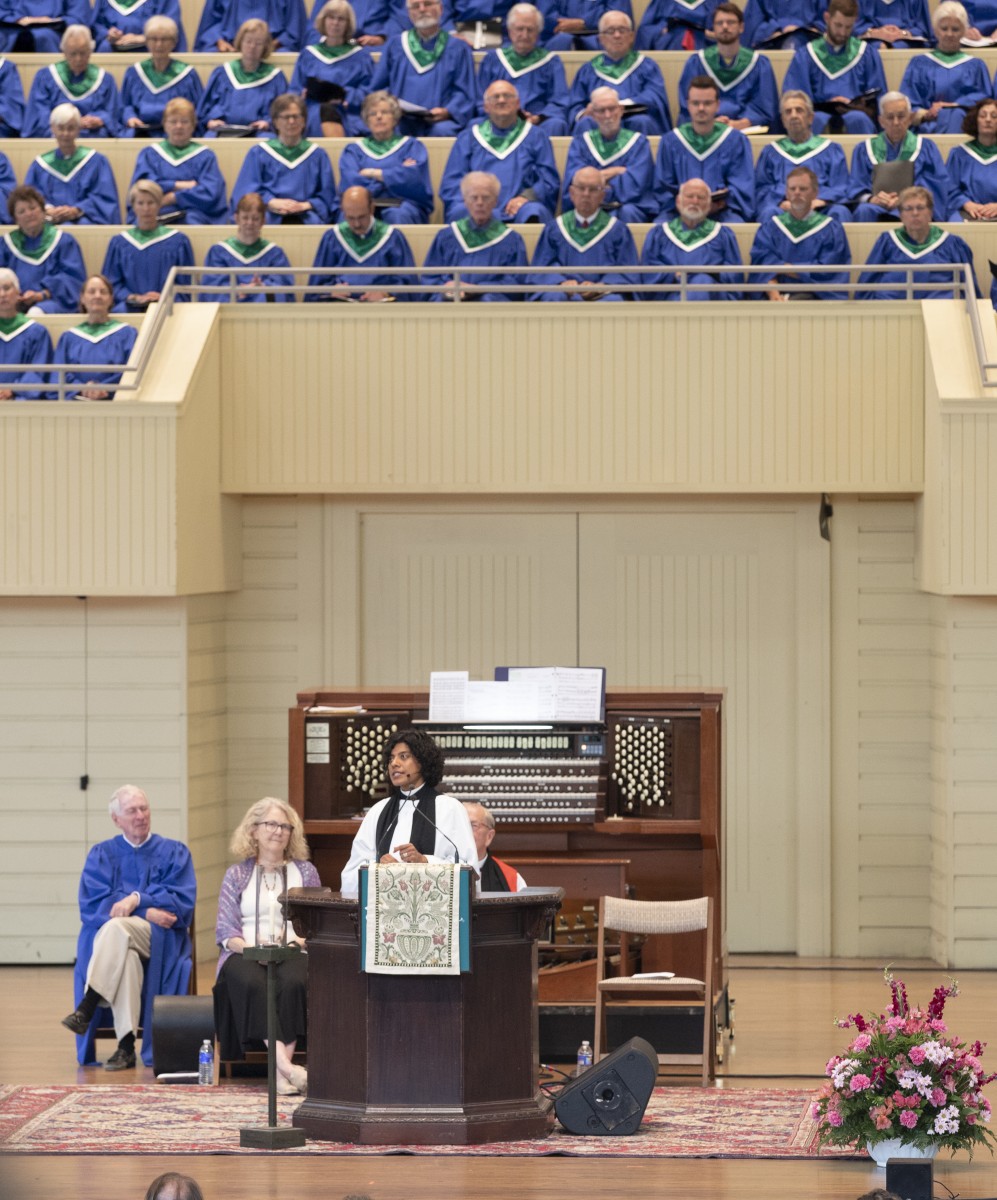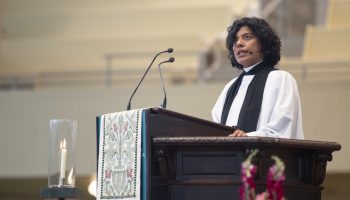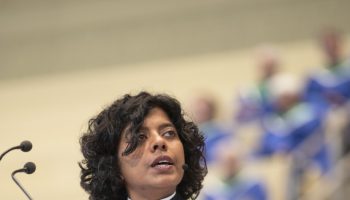The reign of God literally turns over the ways of the world,” said the Rev. Winnie Varghese at the 9:15 a.m. Thursday, Aug. 23, morning worship service in the Amphitheater.
Her sermon title was “Praise God,” and the Scripture text was Luke 2:33-38, the prophecies of Simeon and Anna about Jesus.
Anna’s prophecy about Jesus comes immediately after Simeon said to Mary, “this child is destined for the falling and rising of many in Israel … and a sword will pierce your own soul, too.”
This was not the usual frame for telling a mother good news, Varghese said.
Anna happened by and began to praise God and “speak about the child to all who were looking for the redemption of Jerusalem.”
Luke, in writing his Gospel, was not surprised that Anna was in the temple, and so an 84-year-old woman, a widow for most of her adult life, made it into the story of Jesus.
“We don’t know how she found the child, but she praised God and spoke words of power about Jesus,” she said.
Varghese said she did not look for the details about the temple in Leviticus.
“I could not find if there was a place for widows to go and stay, to fast and pray like Anna, or how many there were,” she said.
As part of a tour of South India with Union Seminary faculty, Varghese went with them on a walking tour of two neighborhoods.
“We know our communities in a narrow way. If you want to see what is right next to you, take a walking tour,” she said.
The first neighborhood was a middle-class one with walled compounds. They were not fancy and were well kept. She could tell where one ended and the next began.
“It was like the community I grew up in. There were no trespassing signs on the lawns and I thought they related directly to the ‘Our Father.’ I could not understand how God cared so much about grass,” she said.
In the middle-class neighborhood, there was no one in the street. It was hot and everyone was at work or inside.
The group crossed the railroad tracks into a poor settlement.
“People were in streets and it was obvious that most people worked in their homes. There was a lively local economy,” Varghese said.
They saw a child in a doorway, shivering with dengue fever. There is no cure, she said, but to hydrate the child and “hope, watch and pray. The area was full of truth like that.”
The group passed by a mosque and a church and found a small Hindu temple. Varghese was curious about which deity was honored there.
“I never figured that out, but we were welcomed into the little courtyard and shed that made up the temple,” she said. “There was an old woman, like Anna, lighting the fires. She showed where to take off our shoes and how to do the rituals right.”
At that time in India, there was great public discussion about women in holy places. Many people thought that India was becoming too Westernized and that only men should be in the temples because that was their tradition and identity.
“I thought she was just getting the place ready for someone else, but this was her place,” Varghese said.
Varghese said that men often sit in the front of ritual places and it is clear when people break their rules. Women are never invited to come closer.
The woman in the temple, Varghese realized, was transgender.
“I was so self-absorbed that I had not observed that. She was at ease in her home and she made us welcome with authority,” she said.
It is from this poor settlement that Varghese carries the image of the reign of God within herself.
“These are the sights and smells that come to mind with Anna and Simeon in the text,” she said. “They give praise to God for the radical reordering of the world.”
When Varghese first heard of Bryan Stevenson’s idea for a National Memorial for Peace and Justice, a memorial to those who were lynched, she thought it was a bad idea. But the more she heard about it, she was inspired and began to think of ways to be involved.
She said the recent talk about memorials raised questions about who is honored and what we as a nation honor, what fires we tend.
“The building up and taking down of monuments is contentious,” she said.
The latest controversy at the University of North Carolina, taking down the statue of a Civil War soldier nicknamed “Silent Sam,” made her think about the Rev. Pauli Murray’s house, which is in Durham.
Murray was the first African-American woman ordained as an Episcopal priest. She was an attorney whose book States’ Laws on Race and Color, influenced the legal arguments of Brown v. Board of Education, that segregation was unconstitutional.
She was also a best-selling author. The grandchild of enslaved people, Murray believed that “her mixed blood was the truth of the interrelationship of the races in America,” said Varghese.
Murray was a transgender woman, reacting to that truth as a person of her time, Varghese said, “and an all-around badass.”
Returning to the subject of the National Memorial for Peace and Justice, Varghese said Stevenson has organized the memorial stones by county with the names of the black people lynched etched on the stones.
“We have to understand lynching if we are going to understand mass incarceration and hostility to immigration,” she said.
Each county has been offered its stone if it promises to display it in a public place, where tourists can see it and not forget what happened in that county.
Varghese was invited to attend the pre-opening in April 2018 to bless the memorial. She described her walk down the path where the coffin-like slabs are planted in the dirt, to the lowest point of the path where the slabs look like they are hanging from trees.
At the close of the service, all the musicians gathered and sang “Amazing Grace.”
“This is a sacred song to the black people of America,” she said. “They sang as only the black church can, that ‘grace will lead me home.’ ”
For the last verse the musicians sang, “Praise God, Praise God, Praise God.”
Varghese said, “Underneath these stones of memory, a new shrine is built, a world is turned upside down, there is grace for the downtrodden, glory and dignity for what was lost and now is found.”
The Rev. Virginia Carr presided. Mary Giegengack-Jureller, a member of the Motet Choir and professor emerita of philosophy at LeMoyne College in Syracuse, New York, read the Scripture. The prelude was “Serenade,” by Howard Hanson, former head of the Eastman School of Music and a longtime Chautauquan. Joseph Musser, piano, and Barbara Hois, flute, performed the prelude. The Motet Choir sang “Forever Music,” by Mark Hayes. The choir was accompanied by Ann West, cello, and Jared Jacobsen, organist and coordinator of worship and sacred music, on the grand piano. The Mr. and Mrs. William Uhler Follansbee Memorial Chaplaincy and the Daney-Holden Chaplaincy Fund provide support for this week’s services.





